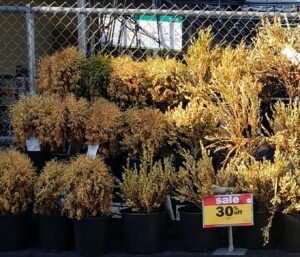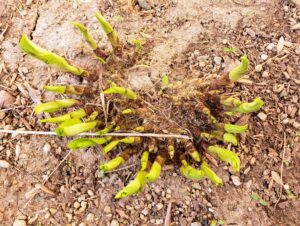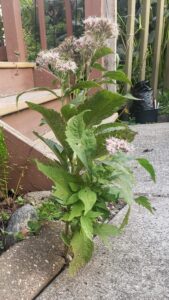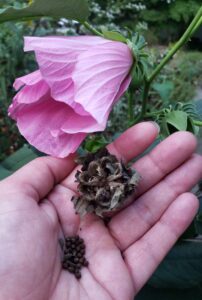Planting may not be the first chore that comes to mind when considering the fall garden, but as Purdue Urban Forestry Specialist, Ben McCallister mentioned in the last issue, it’s an excellent time to install a new tree1. However, trees aren’t the only thing that can be added to the garden this time of year. As temperatures drop, perennial plants are preparing for dormancy and actively moving resources into the root system to ensure survival through the winter. This is true whether it’s a woody perennial or an herbaceous perennial, so take advantage of the end-of-the-season sales (Fig. 1) and add new perennials to garden, but don’t forget about the old.
- Figure 1. Discounts at the end of the season are only as good as the plant material. Selecting healthy plant material is important, especially for a perennial that should live for more than three years.
As herbaceous perennials get older, they may begin to die-out in the center (Fig. 2). The new growth on the outside edge competes for resources in the center. When this occurs, there may be fewer blooms and it’s time to rejuvenate the planting with division. Division is a process of vegetative propagation where a large perennial clump is cut into segments to create clones. Allium, iris, hosta, hardy aster, and bee-balm are just a few examples of perennials that benefit from division every few years.
- Figure 2. Die-it in the center of a hosta is most obvious in spring as new growth emerges.
Before digging up the old perennial (the parent), prepare new holes for the cut segments (the clones). Planting, watering, and mulching the clones quickly after division will reduce transplant shock. To divide a perennial clump, use a spade to cut down into the soil around the edge of the parent plant and gently lift out. Discard the old center and cut the healthy rootstock into segments. Each segment should have four to six buds. Division not only rejuvenates the plant, but provides more plants to fill the garden (and eventually the neighbors garden as well).
- Figure 3. The light-weight seed of Joe-pye weed (Eutrochium fistulosum) is dispersed by wind and it may be found growing far from the parent.
Other perennials will readily propagate in a more conventional method – seed production. Flowers can produce hundreds of offspring as seeds. However, seeds are not clones and may not share the parent plants’ desirable traits. Seed dispersal is also variable and seeds may sprout where they become weeds (Fig. 3). Many of those prolific perennials are setting and spreading seed right now. To gain control of the out-of-control perennials, cut flowers before they go to seed or let them go to seed and harvest for planting in a desirable location (Fig. 4).
- Figure 4. Swamp rose mallow (Hibiscus moscheutos) produces heavy seeds that often drop close to the parent.
Resources:
- Can I Plant Trees in the Fall? – https://www.purduelandscapereport.org/article/can-i-plant-trees-in-the-fall/



